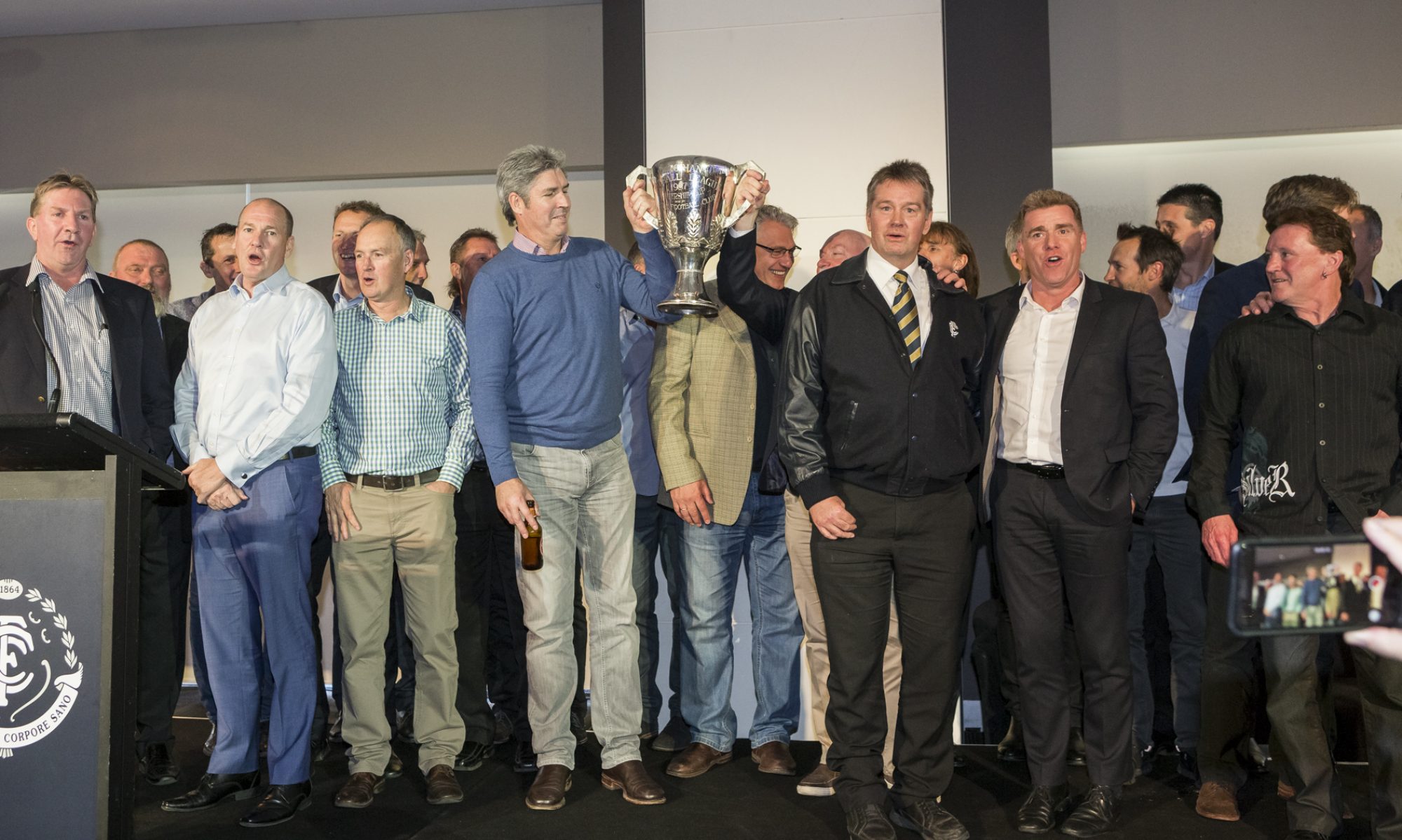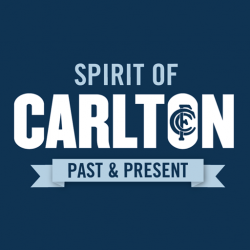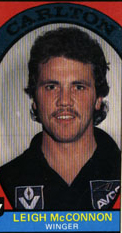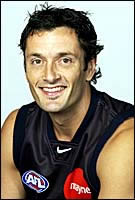A few hours before Vinny Waite’s boy Jarrad booted the first of seven goals for Carlton on the MCG on Friday night, 81 year-old Harvey Laurence Dunn – the first League footballer ever recruited under the father/son rule – lost his three-year battle with cancer.
Harvey died at Frankston Palliative Care earlier that Friday afternoon and there to say goodbye were those who meant the most – his beloved wife of 54 years Jill, daughter Melissa (who had jetted in from London the previous day) and sons Andrew and Neale.
“Dad was as close to perfect as a person could be. He was always interested genuinely in others, selfless to the extreme and never complaining, always positive,” Melissa said on behalf of Harvey’s family.
“My mother noted a song ‘Look Over There’ from the musical Le Cage Aux Folles and the line ‘someone puts himself last so that you can come first’ – that’s Dad in a nutshell.”
Just as family was everything to this most engaging of gentlemen, Carlton was truly family to Harvey also – and while his senior appearances for the team were confined to just nine games, blood ties have bound the Dunns to the Blues for almost 90 years.
For it was on the afternoon of September 6, 1924 in the 18th round match against Richmond that Harvey’s father Harvey Louis Dunn ran down the visitor’s race at Punt Road for the first of 71 matches over the next six seasons as a Carlton player.
A little over a quarter of a century later, Harvey junior was officially cleared to play for Carlton’s senior team in accordance with the newly-introduced father/son rule (eligibility was then 50 games-plus) on May 11, 1951. Next came Melbourne’s Ronald Dale Barassi (March 15, 1953); South Melbourne’s Hugh McLaughlin and Bob Pratt junior (April 15, 1953); Carlton’s NW Huxtable (April 17, 1953); and Fitzroy’s James Chapman (March 31, 1954), whose fathers all represented their respective clubs with great distinction.
Young Harvey set the record straight on his historic recruitment a couple of years ago, when he and this reporter, together with the club’s Video Production Manager Alison Smirnoff and The Age’s Rohan Connolly, paid a sentimental journey to 361 Pigdon Street, North Carlton – the Hawthorn-brick single fronted cottage in which Harvey was born.
“Many years ago there was an article in the paper that Ron Barassi was the first player recruited under the rule, but I was in fact the first. I also dispute the above date my clearance came through and I’ll tell you why,” Harvey said at the time.
“When the under 19s were up and running I was residentially bound to North because I lived in Flemington. I wanted to go to Carlton because of Dad so I applied for a clearance from North, but they wouldn’t give me one. Instead they asked me to train and I trained there for one night in 1949, but I didn’t want to go to North because I was Carlton-mad.
“Now my father knew there was a father-son ruling being considered at the League, so he advised that instead of me going to North in ’49 that I play for Box Hill, then in the Eastern District Football League.

Harvey Dunn Junior during his playing days. (Photo: Carlton Football Club)
“During that year the League brought in the father-son rule, so in 1950 I transferred to Carlton and won the best and fairest in the thirds. I also played in the 1951 and ’53 reserve grade Grand Finals and we won them both.
“When I first went there Perc Bentley was coach of the seniors, Mick Price the reserves and Jim Francis the thirds. My Dad coached Box Hill in ’49 when I was there waiting for this clearance and he later got an offer to coach the Carlton thirds, which he did from 1953 to ’55. I know the thirds got beaten by a point in a Grand Final one year and I also know that Dick Pratt was playing when Dad coached.”
It’s three quarters of a century since Harvey and his family vacated the old Pigdon Street abode, well within walking distance of the old Princes Park ground.
Harvey was barely a toddler then, and it was only recently that he revisited the place where it all began way back in 1931.
“When Dad returned from the First World War he played for Carlton. He was a butcher who lived at 361 Pigdon Street North Carlton, near Bowen Crescent, about a three iron from the ground, and I was actually born in the front room of that house,” Harvey said.
“My family was in Carlton for the first 18 months of my life, but these were Depression days and, unlike today, there wasn’t much welfare . . . so families who couldn’t buy a house were faced with an opportunity to rent a property to Flemington, because things were pretty tough.”
While the Dunn family relocated to Flemington, father and son remained staunchly loyal to the Carlton Football Club. As Harvey said: “As a young kid I used to hear the roar of the crowd and when I went to Flemington I still walked up past the zoo to go to the Carlton ground”.
In his formative years at Carlton, Harvey struck up what proved to be a lifelong friendship with Carlton full-back, the late George Ferry. As Harvey said: “We met up in the thirds, I was best man at George’s wedding and I delivered the eulogy at his funeral service”.
Harvey donned the No.22 guernsey and completed his senior debut – the 650th Carlton player to do so – in the 8th round of 1951, against Collingwood at Princes Park. But unfortunately his appearances in the firsts were all-too-few.
“I felt I was playing pretty good football as a rover and I was getting some good reports all the time, but I don’t think I was getting too many good raps at selection,” he said.
“In 1954 I got an offer to return to Box Hill in the association for a few extra quid because I was getting on a bit. I won the best and fairest there in 1955, but after I married in ’59 I never played again.”
In the ensuing years, Harvey worked for Melbourne City Council and later managed Royal Park Golf Course. Until his health took a recent turn for the worse he was always up for a round on the Mornington Peninsula.
Over the years, Harvey made sporadic silent pilgrimages back to the house in Pigdon Street, where he was born more than three quarters of a century ago. The single fronted cottage with its cast iron fence is built right on the street, but Harvey, until recently, hadn’t mustered the courage to make contact with the kindly owner John McLaren for old time’s sake.

Harvey Dunn Jnr with a photo of his father. (Photo: Carlton Football Club)
“Many times I’ve been tempted to knock on the door, but the owner would probably think of me as a bit silly to look around. If ever I mustered the courage to knock I’d make sure I brought my birth certificate with me, which states ‘born in 361 Pigdon Street, Carlton North’, Harvey said.
When John heard of Harvey’s interest a couple of years ago, he was only too happy to open up so that Harvey could set foot in the front room.
On that sentimental occasion, Harvey came to the house armed with his Dad’s old No.16 dark Navy Blue guernsey and an old scrapbook, bursting with faded sepia clippings of his father’s career and indeed his own career with Carlton. It was clear to see, as he flicked the pages of his glorious youth, that Harvey’s love for the club had not diminished.
“I don’t get to many Carlton games now, but I still follow the Blues from afar. I went to the farewell match at Princes Park and am still a member of the Carlton Past Players,” he said at the time.
“It was really good that Carlton pushed that rule. It was the only way I could play for the team for whom Dad played and for whom I supported since I was a kid.”
At Carlton, the likes of Graeme Anderson, Scott Howell, Peter Kerr, Stephen Silvagni, Jarred Waite, Lance Whitnall and Dylan Buckley were each bound by the father/son rule, just as Harvey Dunn was more than sixty years ago.
And the boy from Pigdon Street wouldn’t have wanted it any other way.
Harvey Laurence Dunn is survived by his wife Jill, daughter Melissa, sons Andrew and Neale, and grandchildren Siena, Blake, Fletcher and Charlie. He is also survived by his sister Gwen and son-in-law Mark.
Harvey’s funeral service is scheduled for 1.30pm this Thursday, June 13, at Mount Martha Uniting Church, 109 Bay Road, Mount Martha.



 Harvey Dunn Jnr outside his old house in Pigdon Street. (Photo: Carlton Football Club)
Harvey Dunn Jnr outside his old house in Pigdon Street. (Photo: Carlton Football Club)







